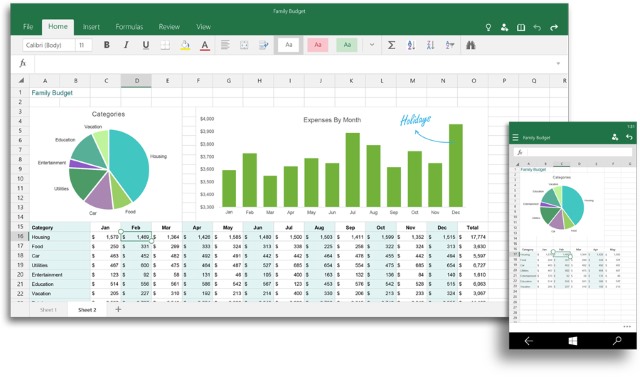Canaux
108470 éléments (108470 non lus) dans 10 canaux
 Actualités
(48730 non lus)
Actualités
(48730 non lus)
 Hoax
(65 non lus)
Hoax
(65 non lus)
 Logiciels
(39066 non lus)
Logiciels
(39066 non lus)
 Sécurité
(1668 non lus)
Sécurité
(1668 non lus)
 Referencement
(18941 non lus)
Referencement
(18941 non lus)
éléments par Robert Gothan
BetaNews.Com
-

Is it time to say goodbye to spreadsheets?
Publié: août 23, 2016, 12:30pm CEST par Robert Gothan
CFOs and Finance Directors have long been warned against the inaccuracies of spreadsheets when it comes to financial planning and analysis. However, as with everything in life, change can often be difficult to accept and this is often the case when it comes to businesses and their financial tools. Sometimes this is because they are reluctant to try something new, but alarmingly, more often than not, it is because the businesses are not aware of the different options available. Research from Accountagility shows that 72 percent of CFOs consider their firms to be too reliant on spreadsheets. The larger the… [Continue Reading] -

As Excel turns 30, it's time to take spreadsheets to the next level
Publié: novembre 23, 2015, 2:37pm CET par Robert Gothan

Excel was born in 1985, and the business world has never been the same. This fall, the program celebrated its 30th birthday, giving spreadsheet users everywhere the chance to reflect on its success, its drawbacks, and its importance in the corporate marketplace. Rather than allowing this major milestone to pass us by, businesses should use the remainder of 2015 as an opportunity to consider their ongoing relationship with Excel.
Microsoft’s dominant spreadsheet software has claimed an unparalleled share of the corporate market, which is an outstanding achievement in itself. However, even though many businesses feel like they can’t live without it, some larger organizations have realized that they can’t live with it particularly well either.
Why Do We Choose Excel?
Microsoft Excel is one of the few tools which simultaneously processes data and presents information. As a result, end users typically prefer to manage their data in a spreadsheet, rather than relying on business intelligence from within the firm. The issue here is that using Excel software in this way places too much focus on presentation, and not enough on process.
Excel has enabled finance departments worldwide to manage increasingly larger data sets, records and plans to cope with ever-growing business demands. In this way, Excel’s agility is hard to beat; company changes require rapid intervention, particularly within finance functions, so it’s clear why it is the program of choice for so many businesses.
However, as end users, we tend to take ownership of any problems that arise within these documents, which means that we often solve them ourselves. As a result, spreadsheets are often not replicable, since calculations and formulas often need to be re-designed when a member of staff leaves. After all, an individual can approach a task in a vast variety of ways -- at task, design and even execution levels -- which makes it very difficult to maintain consistency and control.
The Trouble with Spreadsheets
While spreadsheets clearly play an important role within finance, problems can (and do) occur and sometimes processes don’t work as well as expected. Spreadsheets are most effective when used as a tactical tool, or as a prototype for a more formal process design.
Although it is easy to create templates on Excel, there is a danger that problems will occur if users rely on the program too greatly. This over-reliance is clearly demonstrated by a recent YouGov poll which revealed that even though 72 percent of medium and large businesses use spreadsheets in their finance functions, 17 percent have suffered a monetary loss due to poor spreadsheets.
One key problem is that end users often do not take Excel’s limitations into account, which is the real reason behind many process glitches. The same survey revealed that only 41 percent of companies had invested in spreadsheet training in the last six months, meaning that over half of corporate Excel users are not up to date with the program’s functionality.
New Solutions
Despite the undeniable advances that spreadsheets have brought to finance departments worldwide, recent industry reports have highlighted the potential for errors -- and the subsequent risks -- associated with large and complex spreadsheets.
Organizations are increasingly looking to address this vulnerability. In most cases, the larger the business, the more spreadsheets are deployed, and the greater the number of issues that occur. While Excel is clearly a vital business tool, firms must also consider affordable alternatives that address these risks, whilst also respecting the need for flexibility that Microsoft’s program offers.
For example, new advances in technology have boosted the popularity of other, more sophisticated programs that eliminate the version control issues plaguing Excel, whilst also offering greater consistency, built-in back-up and compliance support. To stay ahead of the competition, businesses should therefore consider how to best utilize Excel in combination with these newer programs that can reduce the risk of errors.
Excel certainly has its advantages, and businesses have formed a strong attachment with the program over the past three decades. However, 30 years is a long time in today’s fast-paced business world, and with demands altering daily, now is the time to reflect on the relationship.
As such, businesses should assess both the benefits and pitfalls of Excel in order to maximize its use, and also consider how their wider data management processes can be improved in the New Year.
Robert Gothan, CEO and founder of Accountagility.
Published under license from ITProPortal.com, a Net Communities Ltd Publication. All rights reserved.